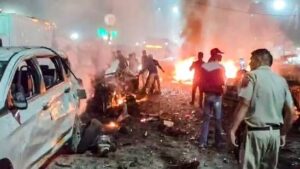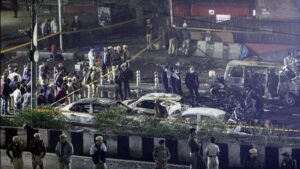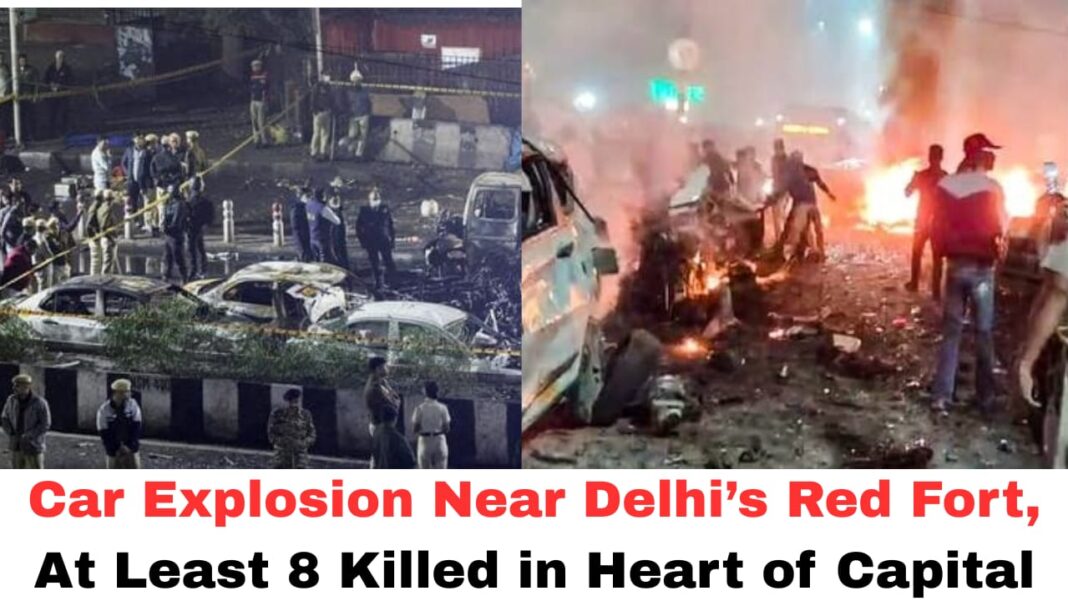Digital News Guru Delhi Desk:
Devastation in the heart of Delhi: Car explosion near Red Fort
On the evening of 10 November 2025, a powerful explosion ripped through a busy street near the historic Red Fort metro station in Delhi. At around 6:52 pm IST (1330 GMT), a slow-moving car—identified as a white Hyundai i20—stopped at a red signal just outside Gate 1 of the Red Fort metro station. Seconds later, it detonated.
Immediate aftermath
The blast was of high intensity. Eyewitnesses described a flash and concussive force that shattered windows, threw debris across multiple vehicles and caused six cars and three auto-rickshaws to catch fire. The explosion occurred in the dense Old Delhi area—a narrow thoroughfare bustling with pedestrians, vendors, and traffic—magnifying the chaos.

Casualty figures vary as the situation evolves. Initial official reports confirm at least eight people killed and more than 19 injured. Some media outlets report higher numbers—up to 12 or 13 fatalities—as investigations progress.
Symbolic backdrop: why the location matters
The Red Fort is not merely a tourist site; it is a national symbol of India’s independence and sovereignty. It is where the Prime Minister delivers the Independence Day address each year. Its proximity to major transport hubs and government institutions makes the incident especially alarming.
An explosion here, in broad daylight, sends a dual message: one of mass vulnerability and one of psychological impact. Officials will now face public scrutiny on how such a vehicle could reach and detonate in one of the city’s highest-security zones.
Investigation: terrorism angle, anti-terror laws invoked
From the outset, authorities have treated the incident as potentially more than an accident. The Delhi Police have registered a case under the Unlawful Activities (Prevention) Act (UAPA), India’s primary anti-terror law, alongside the Explosives Act and relevant criminal statutes.
According to Commissioner Satish Golcha, the vehicle was not parked but was moving slowly, stopped at a signal, and then exploded. Investigators have begun tracing the vehicle’s ownership, conducting forensic analysis of the blast site—and reviewing CCTV footage from the surrounding area.
Some media reports suggest the car had changed ownership multiple times and may be linked to a suspected “fidayeen” module (suicide attack) emerging from earlier explosives seizures in the region. Although authorities have not confirmed these suspicions publicly, they are clearly treating the event with utmost seriousness.

National security response and ripple effects
The explosion triggered immediate security alerts across Delhi and several neighbouring states, including Uttar Pradesh and Maharashtra. Metro stations, airports, and key transport hubs were placed on high alert. Prime Minister Narendra Modi, who was in Bhutan at the time, described the incident as “deeply disturbing” and vowed that “those responsible will not be spared”.
In a city already strained by urban density, pollution, and infrastructure challenges, this blast adds a renewed layer of urgency to security planning — especially for public and tourist locations. It also raises questions about intelligence gaps, screening of suspicious vehicles, and the resilience of emergency response systems.
What comes next
The investigation will aim to answer several key questions:
- Was this a pre-planned terrorist strike, a suicide bomber, or a malfunction/accident?
- Who owned the car, who was driving, and what was their intent?
- How did the vehicle gain access—or remain parked/moving—so close to such a sensitive landmark?
- Were there intelligence signals missed, or security lapses exploited?
Alongside forensic work, the authorities will now likely tighten vehicle screening in Old Delhi, increase surveillance, and review urban security protocols for heritage sites and crowded public zones.
Why this moment matters
This event arrives at a time when India is grappling with multiple internal and external security challenges. An attack in the heart of the capital, near a landmark as emblematic as the Red Fort, hits not just bodies and infrastructure — it strikes the symbolic centre of national confidence.

The incident will reverberate across sectors: tourism may suffer interim setbacks, local commerce in the Old Delhi area could slow due to fear or restricted access, and public trust in urban safety could be shaken. On the strategic level, it tests Delhi’s preparedness for asymmetric urban threats and will likely push policy makers to re-examine how heritage zones, daily commuter corridors, and high-density traffic zones are secured and monitored.
Concluding thought
The car explosion near the Red Fort is a stark reminder of how fragile urban safety can be. When a single vehicle transforms into an instrument of destruction in a crowded public zone, the physical damage is matched by the psychological ripple effects across a city and a nation. In the coming days, as investigators dig into vehicle logs, ownership trails, CCTV footage and forensic samples, the spotlight will be on whether Delhi’s security apparatus can respond not just with urgency—but with enduring structural reform.
You May Also Read: Cold-Wave Alert: North India Braces as IMD Issues Warning for Delhi, Haryana, UP








